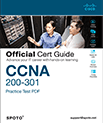Exclusive Courses | Cisco IPv6 Networking Basics - Complete Course (3+ Hours)
This Cisco IPv6 Networking Basics course, spanning over 3 hours, will provide you with a comprehensive introduction to IPv6, the next generation of internet protocol.
- Experienced instructors with industry expertise
- Access to official guides and materials
- Covers all exam topics thoroughly
- Flexible study at your own pace
- Support for exam service
- Anytime access to study resources
What you'll learn
Training Course Outline
Course Introduction
The Need for IPv6
The Features of IPv6
IPv6 Addressing
IPv6 Address Types
IPv6 Addressing Lab
ICMPv6 and Neighbor Discovery
ICMPv6 Lab
Enabling IPv6
Final IPv6 Lab
Training Options
Self Paced Learning
- Lifelong access to high-quality content
- Curated by industry experts
- Customized learning progress
- 24/7 learner assistance and support
- Follow the latest technology trends
Exam Dump
- 100% Real Exam Practice Tests
- 100% Verified Exam Questions & Answers
- 100% Guarantee Passing Rate
- Average 7 Days to Practice & Pass
Description
Internet Protocol version 6 (IPv6) is the latest revision of the Internet Protocol (IP) and the first version of the protocol to be widely deployed. This video will share IPv6 Networking Basics.
Pre-requisites
IPv6 for beginners

CCNA 200-301 Practice Test PDF
SPOTO Free CCNA 200-301 Practice Test PDF. 100% Valid CCNA Exam Questions and Answers from Real Exam.

Free CCNA CCNP Exam Tips Beginner-Friendly Guide
Download CCNA CCNP certification exam guide and tips, help the beginner to study from the very beginning.

31 Days Before Your CCNA Exam (200-301)
This book is designed to provide information about exam topics for the Cisco Certified Networking Associate (CCNA) certification.
Cisco Exam & Certification
What is IPv6, and what is the relationship between IPv6 and Cisco certification?
IPv6 (Internet Protocol version 6) is the latest IP standard designed to replace IPv4, offering a 128-bit address space for scalability and enhanced security. Cisco certification emphasizes IPv6 expertise as it underpins modern network infrastructure. Cisco provides specialized training (e.g., IPv6 Fundamentals, Design, and Deployment course) and tools to configure IPv6 on Cisco devices, aligning with federal mandates for IPv6 adoption in secure, Zero Trust environments. Mastery of IPv6 is critical for network engineers pursuing Cisco certifications, ensuring proficiency in next-gen networking solutions.
What is the necessity for IPv6?
IPv6 addresses IPv4's limitations, notably its 32-bit address exhaustion, by supporting 3.4×10³⁸ unique addresses. This enables direct device connectivity without NAT, essential for IoT, AI, and cloud computing. Additionally, IPv6 enhances security with built-in IPsec and simplifies routing efficiency. Governments and enterprises, including the U.S. federal sector, prioritize IPv6 to meet cybersecurity strategies and future-proof networks. Transitioning to IPv6 reduces complexity and supports global digital growth.
What is the addressing scheme of IPv6?
IPv6 uses a 128-bit address divided into a 64-bit network prefix (global routing prefix + subnet ID) and a 64-bit interface identifier. The interface ID can be manually assigned or auto-generated via EUI-64, which embeds a device's MAC address. Address types include:
- Unicast (global, link-local): Unique device identification (e.g., 2001:db8::/32 for global).
- Multicast/Anycast: Efficient group communication.
Stateless (SLAAC) and stateful (DHCPv6) autoconfiguration streamline deployment.
What are the differences between IPv6 and IPv4?
IPv6 differs from IPv4 in:
- Address length: 128-bit vs. 32-bit, enabling vast address space.
- Header simplification: Fixed 40-byte headers with flow labels for QoS.
- Security: Mandatory IPsec support vs. optional in IPv4.
- Autoconfiguration: SLAAC eliminates DHCP dependency.
- NAT elimination: Direct addressing reduces latency.
These improvements enhance scalability, performance, and security, though dual-stack deployment remains common during the transition.
How to configure and troubleshoot IPv6 networks?
Configuration: On Cisco devices, enable IPv6 routing (ipv6 unicast-routing), assign addresses via EUI-64 or manually, and verify with show ipv6 interface. Use SLAAC or DHCPv6 for autoconfiguration. Troubleshooting:
- Check connectivity with "ping ipv6" and "traceroute6".
- Validate DNS settings and RA messages.
- Use "netsh interface ipv6" (Windows) or debug commands on routers to analyze neighbor caches and routing tables. Cisco's IPv6 Learning Labs and deployment guides offer structured troubleshooting frameworks.